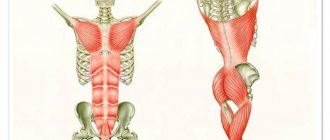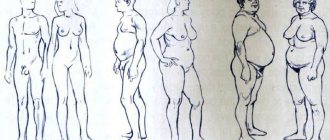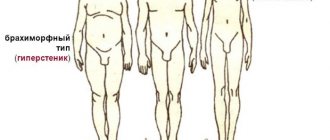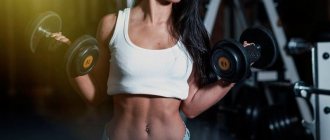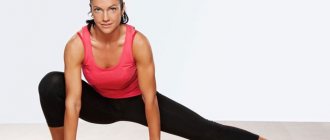The result of a bodybuilder’s performance at competitions and contests depends on many factors. The judges take into account the degree of vascularity, dryness and quality of the athlete's muscle mass. All these parameters are important, but without the correct ideal proportions it is impossible to achieve significant heights in bodybuilding. This is the main reason for the high interest in what proportions in bodybuilding are considered ideal, and whether amateur bodybuilders should strive for these indicators.
Some are of the erroneous opinion that muscle mass is considered the main criterion for a bodybuilder. This is far from the truth. There are a huge number of examples when bodybuilders who weighed less than their opponents became winners of competitions because their proportions were better. For bodybuilding, the beauty of the body is important, and other parameters, including weight, are next in importance.
In search of the ideal
The concepts of body beauty for a man and a woman are completely different from each other. The time period is also taken into account, because, for example, medieval ideals are unlikely to be suitable for the modern world, as well as the location.
The well-known Pythagoras created a rule called the “golden ratio”, which is also used for the human figure. From his point of view, perfection has the following parameters:
- The proportionality of the girth of the neck and wrists corresponds to 2:1.
- The waist is 2 times wider than the neck.
- Equal length of feet and forearms.
- Shoulders width = 1/4 of the owner's height.
Leonardo da Vinci expressed the ideal body in the following proportionality:
- The length of the palm corresponds to the length of 4 fingers.
- Feet = 4 palms.
- Elbows = 6 palms.
- Height is measured by four cubits.
- Arms extended in length are a definition of height.
- The distance between the hair roots and the lower part of the chin is 1/10 of the height, between the crown and the chest is 1/6, between the hair roots and the chest is 1/7, between the crown and nipples is 1/4.
- Shoulders with the greatest width are 1/8 of the height, arm extension is 1/10.
- The distance between the elbows and fingertips is 1/5, between the armpits and elbows 1/8.
- Feet – 1/7.
- The genitals are located in the middle of the body.
- The distance between the beginning of the genitals, kneecaps and toes is 1/4.
- The distance between the roots of the hair and the eyebrows, nose and lower part of the chin is 1/3 of the face, as well as the length of the ears.
In the Middle Ages, a graceful and flexible physique became the standard of male beauty, replacing the sharply declared masculinity and a certain rudeness characteristic of the heroes of antiquity. That is, based on current terminology, men of those times became metrosexual.
Female proportions
Modern girls strive to look as slim as possible. Therefore, classic bodybuilding is not very popular among the fair sex. But body fitness has become widespread - a discipline aimed at the harmonious development of the female body, without gaining extreme muscle mass.
In this sport there are no clear proportions and weight categories, as in men's bodybuilding. Athletes are judged strictly visually. The only gradation of participants is height (158 cm/163 cm/168 cm/over 168 cm).
But even such simplified assessment conditions require long-term, high-quality preparation from applicants. For girls who have never been involved in bodybuilding, we recommend paying attention to the “fitness bikini”.
The main indicators in this discipline are attractive appearance, slender physique, and the absence of pronounced muscle relief. Therefore, beginner athletes can achieve competitive shape in a short period of time.
Note that a fitness bikini requires the presence of a “base”. That is, a girl’s figure by nature must meet certain standards: long legs, low subcutaneous fat content, the correct ratio of chest, waist, and hip volumes. Training and diet should only slightly adjust the existing shape. Therefore, unfortunately, this discipline is not suitable for everyone. But those girls who decide to professionally engage in fitness bikini should take into account the following principles:
- Maximum femininity. Strongly developed latissimus dorsi muscles, prominent deltoids, angular quadriceps - all these are indicators of an athlete-bodybuilder. The main task of bikini girls is to create a slender, toned silhouette without clearly defined muscles. Therefore, choose your mentor wisely. It is best to contact female trainers who have competed directly in the “fitness bikini” category.
- Lack of abs on the stomach. In bikini athletes, the abdominal muscles should not stand out too much. Of course, this muscle requires working out, but without creating a clear relief. Otherwise, the girl may “go beyond” the category and not get into the competition. Therefore, we recommend that you focus on static planks and vacuum, and it is best to avoid power crunches with weights.
- Long legs. Since fitness bikinis are judged on overall proportions, the first thing judges look at is the lower limbs. They should be longer than the upper body. Only with such data can a girl achieve positive results. Athletes with short legs, even on large platforms, will always lose. Girls need to take this point into account if they are going to professionally engage in bikini fitness.
- Feminine breasts. In this sport, this is an important part of the body, as it complements the overall image. Unfortunately, exercises will not work to increase breast size. Therefore, if you do not have naturally attractive shapes, but want to build a sports career in a “bikini,” perhaps you should think about enlargement surgery (we are only voicing the expected obstacles and are not encouraging anyone to go under the surgeon’s knife).
- Worked buttocks. This part of the body is one of the main ones when assessed by judges. You can have long legs, beautiful breasts, a flat stomach, but if the gluteal muscles look undeveloped, you can forget about winning places. Therefore, every “bikinist” who wants to achieve high results must perform squats, lunges and leg presses. For cardio, it is best to use running or walking on a stepper.
If you don’t want to perform on the podium, but are simply trying to get closer to the “90–60–90” standard, general strengthening fitness, aerobics, dancing, running training, active game disciplines, cycling, etc. are best suited for you.
At the same time, do not forget about a balanced diet. The combination of aerobic training and a low-carb diet will help you quickly get rid of subcutaneous fat and tighten your body muscles. The main thing is to exercise regularly.
Modern look
Based on the above, we can come to the following conclusion: there are no strictly established specific standards of the standard. If we focus on visual assessment, women have always been quite conservative in this matter and found attractive a physique with athletic features: pronounced muscles, broad shoulders, narrow hips, tall stature.
But you shouldn’t ignore the fact that weight is not a determining condition. After all, even in the case when the ideal weight has been acquired, but the figure is quite plump, there is no question of perfect proportions!
Height to weight ratio in men
The normal weight and height for men depends on many factors. Firstly, this is directly influenced by heredity, that is, what was inherited from the genetics of the parents. Secondly, composition, nutritional standards, and lifestyle also play a primary role in the correct ratio.
When understanding what correspondence between height and weight in men can be considered correct, we must not forget about the accompanying factors. To do this, you will have to evaluate the degree of physical activity, professional work activity, the specifics of the physique itself, previous diseases and age. Each of the presented indicators needs to be studied and carefully considered in order to get the correct overall picture.
Golden ratio: why know the correct proportions
Only after taking into account all the indicators can you try to derive a formula for the ideal ratio of weight and height for men. Based on such factors, specialists can make a completely appropriate conclusion. But how is everything calculated? Experts usually take a person’s height, weight, chest volume, and bone severity. Moreover, for a healthy adult guy, usually this ratio (height/weight) should remain unchanged throughout the entire time. That is, it should not depend on any external factors.
If the indicator constantly increases, then most likely this indicates weight gain, which ultimately threatens obesity. However, if the number decreases, then this also does not bode well. Loss of weight for no apparent reason can indicate inflammatory processes in the body and the development of diseases. This will allow you to identify problems early so that you can carry out a full examination and begin treatment before things go too far.
Body types: brief description
In the scientific literature you can find a lot of information and references to a person’s somatotype (body type). According to this theory, all body build options can be divided into three main types, which we will now discuss in more detail.
Most people today, as well as online resources, fitness groups and communities, adhere to this system of physique assessment. However, few people know that back in the seventies of the twentieth century, the inconsistency of such a view was recognized by almost the entire scientific community. This happened for a reason, but because in most cases the body shape is combined, and does not fully correspond to all the characteristics of a particular somatotype. The world-famous scientist William Sheldon, the author of a work on temperament (constitution), says that pure body types are actually extremely rare. At the same time, he claims that in almost any person one can find at least minimal signs of the other two somatotypes.
Endomorph
In another way, this body structure can be called hypersthenic. Purely visually, you will never confuse an endomorph with any other group. It is these men who are prone to the accumulation of subcutaneous fat. It is rare that the bone structure of this type of person is thin, small or normal. Usually this is a large-boned skeleton with massive limbs.
At the same time, the arms and legs are not particularly long, which gives such people a squat, stocky appearance even with a small body weight. Guys of this type have a larger waist and hips than others, and all this is supported by serious accumulations of visceral fat in the abdominal area with an incorrect attitude towards body culture.
Ectomorph
This is the complete opposite of the endomorphic type or asthenic body structure. These guys have extremely low body fat levels. This statement is true for both subcutaneous and visceral fat. Usually these are thin people with an elongated figure, thin shoulders that are not broad, and thin limbs. The chest of such guys is poorly developed, it is flat and fragile.
The arms and legs of the ectomorphic somatotype are thin and rather long. At the same time, in sports these types cannot boast of high performance and results. But they have much more developed endurance, and sometimes even agility. Therefore, athletes of this type can show very good results in fitness, athletics and other similar disciplines. Hyposthenics have an accelerated metabolism, which makes it difficult for them to gain muscle mass. This is facilitated by low levels of glycogen in the muscles.
Mesomorph
There are people with an innate propensity for various sports, who are classified as a normosthenic type of build. They are distinguished by an increased level of the male hormone testosterone, and at the same time by a pronounced masculinity (lush facial hair, low voice). Typically, such men have a good appetite and a fast metabolism, which together makes it possible to increase muscle mass at an emergency pace without any obstacles if necessary.
Normosthenic men, for all their muscle mass, usually have minimal subcutaneous and visceral fat deposits. Almost every representative of mesomorphs has a well-developed chest, broad shoulders, and proportional limbs. Their muscle structure is long and wide. Most professional athletes belong to this somatotype.
Classification of body types according to the Solovyov index for men
The weight and height index for men can be determined using Dr. Solovyov’s algorithm. It is not complicated at all, just measure the circumference of your wrist at the thinnest point. The indicators must be indicated in centimeters; they are the index itself, which must then be checked against the presented values.
- Thin-boned or asthenic somatotype - less than 18 centimeters.
- Broad-boned or hypersthenic type - more than 20 centimeters.
- Normal somatotype is 18-20 centimeters.
The second calculation option using the Solovyov index is based on calculating the edge angle. It can be determined using a protractor or by eye, if you can trust yourself. To do this, stand in front of a mirror with your back straight. Place the ribs of both palms on the solar plexus under the chest so that the hands follow the branching of the ribs. It is the angle between the palms that will also be the Solovevo index, which determines the somatotype.
- Asthenics are characterized by an acute angle.
- Hypersthenia implies an obtuse angle.
- In a normal physique, the angle most often has 90 degrees or values as close as possible to this figure.
Carrying out such measurements is not difficult, so even a beginner can cope with the task.
The effect of age on weight
Few people understand that correct calculation of a man’s weight by height and age is only possible if all indicators are taken into account. It is important that the number of years a person has lived must be taken into account. Typically, strong young people are taller than older people, so normal body weight will not be the same for them.
Determining clothing size by hip circumference
To determine the exact size of clothing, it is necessary to correctly measure the horizontal girth of the desired part of the body. Results may be rounded according to typical clothing characteristics. It is not recommended to rely on labels, even if the item fits well.
Determining clothing size by hip circumference
When rounding parameters down, you need to remember that the finished garment will fit tightly to the silhouette. If the values have been rounded up, then the item will “sit” loosely. The sizes of men's and women's clothing (according to hip volume) are indicated in the table.
Women's sizes
According to anthropometric standards, the female figure is divided into several types. Their dimensional characteristics vary.
Main features:
- hip circumference (half circumference is not taken into account);
- chest girth (third option, Og3);
- height.
Female figures are divided into several complete groups. They can be determined by simple mathematical operations: it is necessary to subtract the values of Og3 from the OB indicators.
Body types
The following standards were adopted in the CIS:
- First group. The difference between hip volume and chest volume is 1-2 cm.
- Second group. The difference between hip volume and chest volume is 5-6 cm.
- The third group, the difference between the volume of the hips and the volume of the chest is 9-10 cm.
- Fourth group. The difference between hip volume and chest volume is 13-14 cm.
- Fifth group. The difference between hip volume and chest volume is 18 cm.
Sixth group (zero completeness). The difference between hip volume and chest volume is 2 cm.
Table of sizes of women's skirts, trousers, shorts according to hip volume (other indicators are also indicated):
| Sizes in CIS countries | Int (international format) | Hip volume | Waist | Bust volume |
| 70 | 5XL | 141-144 cm | 137-140 cm | 140-143 cm |
| 68 | 5XL | 137-140 cm | 131-134 cm | 136-139 cm |
| 66 | 5XL | 134-136 cm | 127-130 cm | 132-135 cm |
| 64 | 4XL | 131-134 cm | 124-126 cm | 128-131 cm |
| 62 | 4XL | 128-131 cm | 118-121 cm | 124-127 cm |
| 60 | 4XL | 125-128 cm | 112-115 cm | 120-123 cm |
| 58 | XXXL | 122-125 cm | 108-111cm | 116-119 cm |
| 56 | XXL | 119-122 cm | 104-107 cm | 112-115 cm |
| 54 | XXL | 116-119 cm | 100-103 cm | 108-111 cm |
| 52 | XL | 113-116 cm | 94-97 cm | 103-107 cm |
| 50 | L | 110-113 cm | 92-94 cm | 99-102 cm |
| 48 | L | 107-110 cm | 90-93 cm | 95-98 cm |
| 46 | M | 104-107 cm | 84-87 cm | 91-94 cm |
| 44 | M | 101-104 cm | 80-83 cm | 87-90 cm |
| 42 | S | 98-101 cm | 64-67 cm | 83-86 cm |
| 40 | XS | 95-98 cm | 60-63 cm | 79-82 cm |
| 38 | XXS | 92-95 cm | 56-59 cm | 75-78 cm |
The measurements of the waist, hips and chest may vary depending on the individual characteristics of the female figure.
Men's sizes
Male figures are also classified according to the type of fullness.
To determine it, you need to subtract the waist measurements from the chest volume values:
- First group. The difference between chest and waist volume is 21-22 cm.
- Second group. The difference between chest and waist volume is 15-16 cm.
- Third group. The difference between chest and waist volume is 9-10 cm.
- Fourth group. The difference between chest and waist volume is 3-4 cm.
- Fifth group. The difference between bust and waist volume is 1-2 cm.
Groups are arranged in descending order. Negative values are achieved due to the characteristic excess of OT to Og3 indicators.
Dimensions for men's shorts and trousers:
| Size (standard designation) | Hip volume | Waist |
| 68 | 134-137 cm | 122-125 cm |
| 66 | 131-134 cm | 119-122 cm |
| 64 | 128-131 cm | 116-119 cm |
| 62 | 125-128 cm | 113-116 cm |
| 60 | 122-125 cm | 110-113 cm |
| 58 | 118-122 cm | 107-110 cm |
| 56 | 115-118 cm | 104-107 cm |
| 54 | 112-115 cm | 101-104 cm |
| 52 | 109-112 cm | 108-101 cm |
| 50 | 106-109 cm | 105-108 cm |
| 48 | 103-106 cm | 102-105 cm |
| 46 | 100-103 cm | 99-102 cm |
| 44 | 97-100 cm | 96-99 cm |
It should be remembered that the main indicator when choosing shirts, sweaters and shirts is chest girth.
How to calculate Sat
If a person is not overweight, then simply wrap the tailoring tape around the back of the thigh so that it closes on the right side in front. The method is suitable for people with a flat stomach.
If you are overweight, you can measure your hip circumference as follows:
- wrap a lace or thick thread around your hips;
- make marks on the right and left sides, exactly in the center;
- cut off excess (ends of twine);
- measure the length of the remaining part of the lace.
First you need to find the highest part of the buttocks. Typically, a tailor's tape measure is wrapped around the convex part of the hips (the tape is placed a few centimeters below the waist). Also, when sewing clothes, you may need hip length.
Many people mistakenly wrap the tailoring tape around one thigh. It is necessary to visually divide the side of the thigh into 2 parts and mentally mark the central point. Place the metal end (the beginning of the sewing tape measure) at one point and stretch the tailor's tape to another point. Write data.
You need to measure the volume and semi-circumference of your hips correctly so that your custom-made clothes fit perfectly. To obtain accurate indicators, measurements are taken in front of a mirror. It is advisable to remove all outer clothing, leaving only a thin shirt or underwear. It is not recommended to eat before measurement.
Parameters of famous athletes
Values are given in centimeters and kilograms:
| Athlete | Height Weight | Neck | Biceps | Breast | Waist | Hip | Shin |
| A. Schwarzenegger | 188/115 | – | 56 | 145 | 81 | 71,5 | 50,5 |
| Lou Ferrigno | 197/118 | – | 55 | 145 | – | 74 | 48 |
| I. Poddubny | 184/120 | 50 | 45 | 134 | 104 | 70 | 47 |
| G. Gakkenshmidt | 176/93 | 50 | 47 | 125 | 85 | 68 | – |
| D. Yates | 181/114 | – | 57,5 | 145 | – | – | 55 |
| S. Oliva | 179/102 | – | 54 | 140 | 75 | 73 | 47 |
Children's sizes
When choosing children's clothing, it is necessary to take into account the height and weight of the child. Newborns usually buy things 1-2 sizes larger.
Dimensional characteristics:
| Child's age | Weight | Height | Hip volume | Waist | Bust volume | Size |
| 12 years | 34-37 kg | 150-153 cm | 80-81 cm | 80-81 cm | 80-81 cm | 38 |
| 11 years | 32-35 kg | 144-147 cm | 74-79 cm | 74-79 cm | 74-79 cm | 36 |
| 10 years | 30-33 kg | 140-142 cm | 70-74 cm | 70-74 cm | 70-74 cm | 34 |
| 9 years | 28-31 kg | 132-135 cm | 68-73 cm | 68-73 cm | 68-73 cm | 32 |
| 8 years | 26-29 kg | 126-129 cm | 65-69 cm | 65-69 cm | 65-69 cm | 32 |
| 7 years | 24-27 kg | 120-123 cm | 62-65 cm | 62-65 cm | 62-65 cm | 30 |
| 6 years | 22-25 kg | 114-118 cm | 56-60 cm | 56-60 cm | 56-60 cm | 30 |
| 5 years | 20-23 kg | 110-112 cm | 54-58 cm | 54-58 cm | 54-58 cm | 28 |
| 4 years | 17-19 kg | 107-110 cm | 52-55 cm | 52-55 cm | 52-55 cm | 28 |
| 3 years | 15-17 kg | 105-108 cm | 50-53 cm | 50-53 cm | 50-53 cm | 26 |
| 2 years | 13-15 kg | 97-100 cm | 49-51 cm | 49-51 cm | 49-51 cm | 26 |
| 1 year 6 months | 10-12 kg | 85-89 cm | 46-48 cm | 46-48 cm | 46-48 cm | 24 |
| 1 year | 8-10 kg | 79-83 cm | 43-45 cm | 43-45 cm | 43-45 cm | 24 |
| 6-9 months | 6-8 kg | 72-75 cm | 40-42 cm | 40-42 cm | 40-42 cm | 22 |
| 3-6 months | 5-7 kg | 69-71 cm | 38-40 cm | 38-40 cm | 38-40 cm | 22 |
| 90 days | 4.5-6 kg | 62-65 cm | 36-39 cm | 36-39 cm | 36-39 cm | 20 |
| 60 days | 4-5 kg | 53-56 cm | 35-37 cm | 35-37 cm | 35-37 cm | 18 |
| 30 days | 3.5-4.5 kg | 50-53 cm | 33-35 cm | 33-35 cm | 33-35 cm | 18 |
When choosing children's clothing, you need to pay special attention to the quality of the material. Synthetic fabric may cause an allergic reaction.
Older generation
Representatives of the Greek nation generally respect old age. There are much more pensioners in the country than in Russia. Their faces are usually filled with serene calm and peace so that it becomes clear that they are getting a well-deserved rest. Life expectancy in Greece is also high – it reaches 80 years. Having a Mediterranean climate, healthy food, sunshine and a relaxed attitude to life obviously does the trick. There is a lot to learn from them.
The mother has the main unquestioned authority in the family; she actually personifies Hera along with Athena. Family ties are very strong. Thus, weekly lunches with mothers are traditional. Their sons are devoted to them all their lives, fulfill all their requests, and listen to their advice. It is clear that the search for a bride is carried out by the Greeks with a focus on the qualities that the mother demonstrated. Most often, families are created at the age of 30. The Greeks do not deny themselves the pleasure of living a happy, free youth and having fun.
How to easily determine the widest part of your hips
When sewing outerwear or waist items (shorts, trousers, leggings, jeans, skirts), several anthropometric points are found on the human body. This is necessary for the item to fit perfectly to your figure.
You need to determine:
- Gluteal point. A tailor's tape measure is wrapped around the protruding part of the buttocks (approximately in the middle).
- Pelvic point. The tailoring tape is lowered to how many centimeters below the waist (approximately under the thigh bone).
- Femoral point. The tailor's meter should be lowered 4-5 cm below the pelvic point.
To measure OB, you need to wrap a measuring tape around the protruding part of the buttocks.
Experts recommend recording all received readings. For accuracy, you can measure the same body part several times. In addition to the hip circumference, to sew outerwear you also need to measure the height, second girth and half-circumference.
To find out a person's OB, you need to wrap a tailor's tape measure around the protruding part of the buttocks. The height of the hips is measured from the side: a tailor's centimeter is applied to the waist and lowered to the hip.
To measure the second girth, you need to find the so-called “breeches” (there are fat deposits on the outer side of the thigh). It is around them that you need to wrap the tailor's centimeter.
Recommendations
The tips below will help you take measurements as accurately as possible:
- Professional athletes need to determine progress using measurements once a week. It's best to do this on Friday.
- You need to apply the centimeter in the same place. Otherwise, the results will vary.
- Each parameter should be measured at least three times. This will avoid incorrect indicators.
- The measurement procedure is best done in the morning on an empty stomach. At this time, the muscles are relaxed and have a natural shape.
To record your progress, keep a diary. Write down the results of each check in it, and also attach your own photographs. All this will help track the growth of muscle mass and will further motivate you to exercise.
